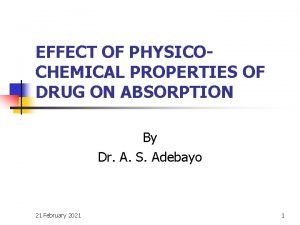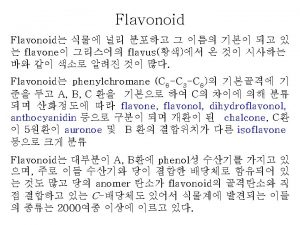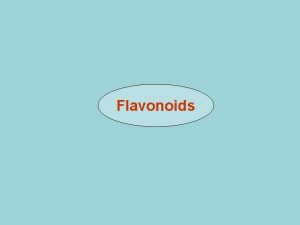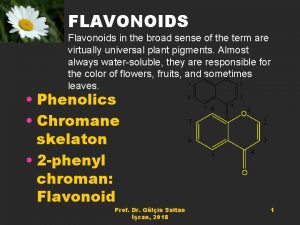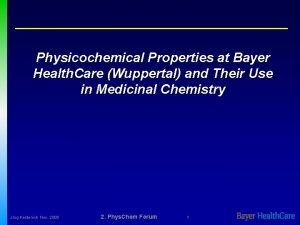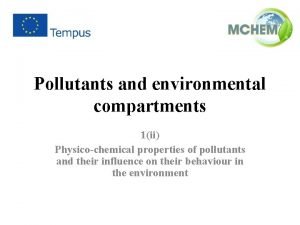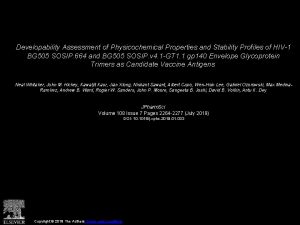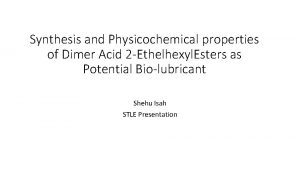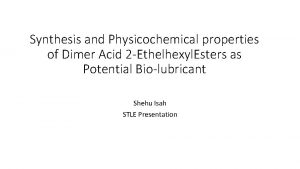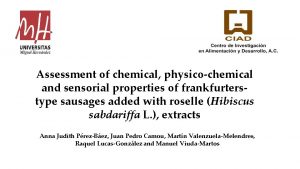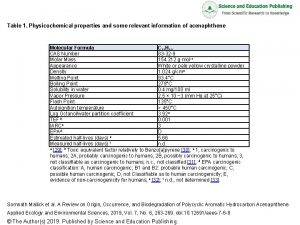Study of physicochemical and pharmacokinetic properties of flavonoids



















- Slides: 19

Study of physicochemical and pharmacokinetic properties of flavonoids from Euterpe oleracea Martius Nayana de Oliveira 1, Marcos Almeida 1, Rodrigo Cruz 2, Lorane Hage-Melim 1, * 1 Laboratory of Pharmaceutical and Medicinal Chemistry (Phar. Med. Chem), Federal University of Amapá, Macapá, Amapá 68902 -280, Brasil. 2 Laboratory of Nanobiotechnology Phytopharmaceutical, Federal University of Amapá, Macapá, Amapá 68902 -280, Brasil. * Corresponding author: loranehage@gmail. com 1

Study of physicochemical and pharmacokinetic properties of flavonoids from Euterpe oleracea Martius 2

Abstract Neurodegenerative disorders prevalence is growing due to life expectancy increase, thus the passage signs of time are clearly visible in the brain. Oxidative stress is a factor that contributes to the organic defenses imbalance, producing free radicals, brain-aging progression and various degenerative diseases. Macromolecules oxidative damage increases with age, leading to a progressive decline in cell and tissue function. Antioxidants reduce these free radicals formation or react with them by neutralizing them. Euterpe oleracea Martius, popularly known as açaí, is rich in α-tocopherol, fibers, lipids, polyphenols and mineral ions. Believes that polyphenols high content, among them flavonoids, confers to açaí fruits a variety of health promoting effects, including anti-inflammatory, immunomodulatory, antinociceptive and antioxidant properties. The present study aims to analyze, in silico, flavonoids physicochemical, pharmacokinetic and toxicological properties present in Euterpe oleracea Martius. Methodology: Initially, selected 16 molecules present in Euterpe oleracea Martius, divided into açaí pulp and oil. The physicochemical properties of the flavonoids were analyzed by the rule of 5, pharmacokinetic properties in the Qik. Prop module of the Schrödinger software and the toxicity profile using the DEREK program. Results: Among physical-chemical properties, the flavonoid compounds catechin, epicatechin, luteolin, chrisoeriol, taxifolin, apigenin, dihydrocaempferol, isovitexin and vitexin presented good oral bioavailability. In pharmacokinetic properties, the molecules catechin, epicatechin, isovitexin, luteolin, chrisoeriol, taxifolina and isorhamnetina rutinosídeo presented the best results and high human oral absorption. In toxicological properties prediction the compounds presented good results, except for the isorhamnetina rutinoside and rutin compounds that presented alert about the mutagenicity for hydroxynaphthalene or derivative. Conclusion: Catechin, chrysoerythol and taxifolin flavonoids presented the best results, but other computational and experimental methods are needed to identify these compounds biological activity. Keywords: Flavonoids. Acai. Euterpe oleracea Martius. Antioxidants. 3

Introduction Medicinal plants in Brazil It is the country that has the highest biodiversity on the planet, estimated at around 20% of the total of existing plant species (NUNES & MACIEL, 2016) Currently, more than 45% of pharmaceutical products come from natural products (NUNES & MACIEL, 2016) SOURCE: http: //www. pronoticia. com In Amapá, floodplain forest occupies 4. 8% of the State, this ecosystem presents a wealth of palm trees, emphasizing the Euterpe oleracea Martius (açaí) (SILVA, 2002). 4

Introduction Phytochemical composition of Euterpe Oleracea Martius Orientin Isovitexin Euterpe Oleracea Martius Rich in bioactive polyphenols, especially flavonoids (YAMAGUSHI et al. , 2015). Taxifolin deoxyhexose 5

Introduction Flavonoids They may be subdivided into flavones, flavanoids, isoflavones, flavonols and anthocyanins (LI et al. , 2009). They are antioxidant molecules, of vegetal origin that offer perspectives in oxidative damages prevention (JIT et al. , 2016). Basic flavonoid structure (PANCHE et al. , (2016) In the açaí pulp, the most abundant phenolic compounds are anthocyanins, proanthocyanidins, other flavonoids and lignans (KANG et al. , 2011). 6

Results and discussion • Physicochemical Properties 7

Results and discussion • Most of selected flavonoids did not violate Lipinski's Rule. • The compounds 9 and 11, present in the pulp of açaí, 1 presented 3 violations not favoring the bioavailability in the organism. • Compound 6 showed 2 violations. • Only compounds 1, 2, 5, 7, 8, 10, 12, and compounds 3 and 4 which have had a violation have physicochemical properties deemed necessary for a good bioavailability in the body for planning of a future drug candidate by oral route. 8

• Dos Santos (2014) stated in his study that the phenolic compounds luteolin and taxifolina also did not violate any parameter of the Lipinski rule, having a good oral bioavailability. • Regarding molecular weight, Vetrova et al. (2017) disagree with the present results, stating in their studies that rutin has antioxidant activity with broad potential for protection, low molecular weight and is widely distributed in vegetables and fruits. 9

Results and discussion 10

Results and discussion • According to Silva and Rogez (2013), in fixed oils of E. oleracea there is a flavonoid profile similar to that described for pulps, where the main phenolic compounds are gallic acid, cyanidin-3 -O-glucoside and cyanidin-3 - O-rutinoside. • Thus, 4 molecular structures of flavonoids present in açaí oil (Euterpe oleracea) were selected. 11

Results and discussion 12

Results and discussion • Compounds 1, 7, 8 and 9 showed high AOH; • Compounds 2, 3, 4, 5 and 6 had mean AOH; • Compounds 10, 11 and 12 have low AOH, indicating that oral to the latter route would not be a good choice. • A study of açaí pulp and clarified E. oleracea juice by oral route, observed that total anthocyanin levels reached maximum concentrations of 2321 ng / L in time of 2. 2 hours and 1138 ng / L in 2. 0 hours, respectively , and plasma antioxidant capacity increased significantly after the pulp ingestion (MERTENS-TALCOTT et al. , 2008). 13

Results and discussion • Compounds 1, 2, 3, 4, 5, 6, 7, 8 and 9 presented mean % AOH; • Compounds 10, 11 and 12 had low % AOH. • It is observed that compounds 10, 11 and 12 are weak candidates in this respect, presenting disadvantage in relation to the others in the pulp (MERTENS-TALCOTT et al. , 2008). • For drugs that act on the central nervous system, penetration into the blood-brain barrier (BBB) is essential. • Compounds that have Cbrain / Cblood> 1 values are able to cross BHE and compounds with values below 1 do not act on the CNS (MA; CHEN; YANG, 2005). As observed in Table 3, only compounds 4, 10 and 12 presented values that were not recommended. In contrast, most compounds are promising for CNS activity. 14

Results and discussion 15

Results and discussion • Lipophilicity, measured by log. P, is one of the physicochemical properties that most influence a molecule ability to move through biological compartments (CLEMENTE, 2011). • The results found (Table 4) show that açaí oil flavonoid molecules are more lipophilic than hydrophilic, meaning that the plasma proteins are more easily bound, facilitating the compound distribution by biological organism. 16

Results and discussion • The acai oil has a high content of unsaturated fatty acids. • It is great interest to the food and beverage industries that seek alternatives to produce healthier products (HORNSTRA, 1999). • The fixed oil contained in açaí tree fruits represents approximately 50% of the total dry matter of the pulp and presents a lipid profile. • Acai oil is a valuable byproduct because of its unique sensory properties and potential health benefits (BICHARA; ROGEZ, 2011). 17

Conclusions • Catechin, chrysoerythol and taxifolin flavonoids presented the best results, but other computational and experimental methods are needed to identify these compounds biological activity. 18

Acknowledgments 19
 Physicochemical properties of drugs
Physicochemical properties of drugs Physicochemical properties of drug absorption
Physicochemical properties of drug absorption Biosynthesis of flavonoids shikimic acid pathway
Biosynthesis of flavonoids shikimic acid pathway Pharmacokinetic phase
Pharmacokinetic phase Difference between pharmacodynamics and pharmacokinetics
Difference between pharmacodynamics and pharmacokinetics Cmax in pharmacokinetics
Cmax in pharmacokinetics Difference between intensive and extensive properties
Difference between intensive and extensive properties Chemical property of water
Chemical property of water The study of composition structure and properties
The study of composition structure and properties Process of method study
Process of method study Objective of work study
Objective of work study Time and motion study example ppt
Time and motion study example ppt Phonetics
Phonetics What is case series
What is case series Retrospective cohort study
Retrospective cohort study Marty lobdel
Marty lobdel Study to study
Study to study Properties of kite
Properties of kite Sam and verna coursework
Sam and verna coursework 6-5 study guide and intervention rhombi and squares
6-5 study guide and intervention rhombi and squares

